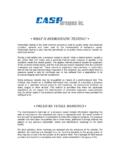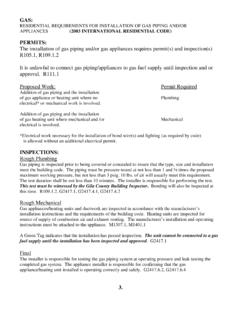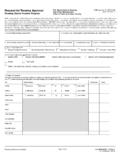Transcription of What is Manufactured Gas? - Heritage Research
1 what is Manufactured Gas? Manufactured gas should not be confused with natural gas, the primary fuel gas of our day. Manufactured , or artificial gas, was produced from coal, coal and oil mixtures, or from petroleum. Almost without exception, in the US Manufactured gas was produced by means of three processes: Coal Carbonization Carburetted Water Gas Oil Gas Coal Carbonization / Coal Gas Process This was the primary, commercial mode of manufacturing gas from ca 1816 to 1875. After 1875, newer processes and technologies gradually replaced coal carbonization. Coal gas was produced through the distillation of bituminous coal in heated, anaerobic vessels called retorts. In this process, coal was broken down into its volatile components through the action of heat in a nearly oxygen free environment.
2 During the retorting phase, approximately two-fifths of the coal's weight was converted into volatile non-solids or gases. Most of the remaining amount of the coal was converted into solids, primarily coke. From the retort, the gases were drawn off into a device known as the hydraulic main where some of the vapors were converted to liquids and remained in gaseous state. The liquids, or liquors as they were often referred to, consisted of (contaminated) water and coal tar, and its associated wastes. The remaining vaporous material was coal gas. After exiting the hydraulic main, the gas ran through a condenser where the gas cooled and additional coal tar and other impurities were removed. Quite often, the gas was next funneled through a device known as an exhauster, which further cooled the gas.
3 The coal gas, however, still contained impurities, primarily gaseous ammonia and sulfur compounds. These were removed by "washing" the gas in water and by running the gas through beds of moist lime or moist iron oxides. After this final purification process, the coal gas passed through the station meter, where it was measured, and on to gas storage holder. From the holder the gas was distributed via street mains to the consumer. Carburetted Water Gas Process In 1873, Professor L. Lowe of Pennsylvania invented the carburetted water gas process a technological advance that spurred on the growth of America s Manufactured gas industry. At its core, the process consisted of enriching a form or coal gas, known as water gas (blue gas) and thus increasing its caloric / energy value. By injecting oil into a vessel containing heated water gas, the oil and vapor combined, forming a gaseous fuel with a thermal content of approximately 300-350 Btu per cubic foot.
4 Within a few short years, carburetted water gas came to dominate the Manufactured gas industry in the US, as residential and industrial consumer alike demanded the more efficient fuel source. Typically, a carburetted water gas plant consisted of a brick-lined, cylindrical, steel vessel, the generator, the carburetor (carburetter), and a superheater. It was in the generator that the coal or coke was distilled to generate gaseous product. As the gas was drawn off from the generator and passed into the carburetor, the oil was introduced into the vapor. The oil-gas mixture then traveled down through the carburetor and up through the superheater. During the course of its passage through the superheater, the oil was thermally cracked and became "fixed" thoroughly mixed and bonded with the coal gas.
5 Carburetted water gas was, then, a mixture of the gaseous products of coal and petroleum. From the superheater, the carburetted water gas was fed into a sealed wash box where the gas cooled slightly, allowing some the impurities in the form of coal tar (and associated wastes) to condense and settle out. The gas was then passed through the condensers where it was cooled even further, and additional coal tar and impurities were removed. The gas was also passed through a scrubber, a device that brought the vapor into direct contact with water, thus removing even more impurities from the gas. Depending upon the size and design of the plant, some facilities employed additional mechanical scrubbing devices to produce carburetted water gas. Common scrubber processes included: The wire drawing or friction method - - while still heated, the gas was driven through a series of fine orifices.
6 As a result of friction and changes in the velocity of flow, impurities, including coal tar, settled from the vapor. The shaving scrubber method - - the vapor was passed through beds of absorbent materials (wood chips, lime and iron oxides were sometimes used), thus removing coal tar and other contaminants from the gas. Direct current electrical precipitation method- - electrical currents were passed through the vapor, charging the particles of coal tar and other impurities in such a manner that they precipitated out from the gas. After scrubbing, the gas was moved into the relief holder, which served as a reservoir that provided a continuous gas supply to the exhauster. From the relief holder, the gas passed through the exhauster, through the final stage purifiers, into the station meter, and on to the storage holder.
7 From there the gas entered the distribution system and was delivered to the consumer. Oil Gas Process The oil gas process is the only one of the three Manufactured gas processes discussed here that did not use coal as a raw material. The first large-scale oil gas plant went on line in Oakland, CA, in 1902. The process as a whole was very similar to carburetted water gas process. In essence, the oil gas process consisted of thermo-cracking oil in a steam environment to produce the raw gas rather than distilling coal. The oil was heated and cracked in a vessel similar to the generator used in the carburetted water gas process. From there the gas passed to a vaporizer, where it was enriched with additional injections of oil and then routed through the superheater. After exiting the superheater, the gas was scrubbed and processed for distribution in much the same way as was carburetted water gas Many of the same waste products associated with the production of coal gases, notably tars containing PAHs, were also generated during the manufacture of oil gas.
8 How Many Manufactured Gas Plants Were There? The US EPA and others estimate that from ca. 1815 to ca. 1960 over 50,000 Manufactured gas plants operated in the United States. How many operated at a given time is difficult to say--a handful of commercial plants operated in 1816, nearly 400 in 1860. Approximately 700 plants operated in 1890, 900 in 1900, and over a thousand Manufactured gas plants in 1905. There were perhaps 1,300 plants producing Manufactured gas in 1909. By the 1920s, the Manufactured gas industry had reached its maturity in the US. In 1921, it was estimated that over 9 million domestic customers used Manufactured gas to heat their homes, cook their food and fuel their household appliances. Manufactured gas served an estimated 46 million individual Americans in some 4,600 communities across the land.
9 Residential customers consumed over 326 billion cubic feet of Manufactured gas in 1921. The numbers are more difficult to discern in later years, but there is a substantial decline in the number of Manufactured gas plants in operation as the century progressed. In 1939 there were perhaps as few as 100 plants in operation producing gas and coal / coal tar byproducts. The post war years saw an increase in the number of such plants with approximately 170 in operation in 1947. By the late 1950s only a few plants operated, largely supplying feedstocks to a chemical industry that was ever increasingly relying upon the petroleum industry for its raw materials. By the mid-1960s the remaining plants closed due to a lack of demand for coal and coal tar by-products. Where Were Manufactured Gas Plants Located?
10 At the onset of the Civil War, every state in the Union (as well as the District of Columbia) except for Arkansas was home to at least one Manufactured gas plant. Circa 1860, New York led the nation with 61 gas works operating within its borders, followed by Pennsylvania with 48 and Massachusetts with 45. Number of Manufactured Gas Companies in the US, ca. 1860 State Number of Companies Capital Coal Gas Plants Resin / Oil Gas Plants Alabama 3 320,000 3 0 Arkansas 0 0 0 0 California 9 1,790,000 9 0 Connecticut 14 953,000 14 0 Delaware 3 244,300 3 0 District of Columbia 1 500,000 1 0 Florida 1 30,000 1 0 Georgia 6 559,160 4 2 Illinois 13 2,595,000 13 0 Indiana 7 605,000 7 0 Iowa 5 355,000 5 0 Kansas 1 200,000 1 0 Kentucky 5 905,000 5 0 Louisiana 2 1,540,000 2 0 Maine 10 905,300 9 1 Maryland 6 780,000 3 3 Massachusetts 49 4,759,000 45 4 Michigan 8 745,000 8 0 Minnesota 1 200,000 1 0 Mississippi 4 212,000 4 0 Missouri 4 775,000 4 0 New Hampshire 9 425,000 9 0 New Jersey 19 1,849,610 17 2 New York 71 12,780,250 61 10 North Carolina 8 187,000 0 8 Ohio 30 3,338,600 29 1 Oregon 1 50,000 1 0 Pennsylvania 48 5,657,700 48 0 Rhode Island 7 1.





